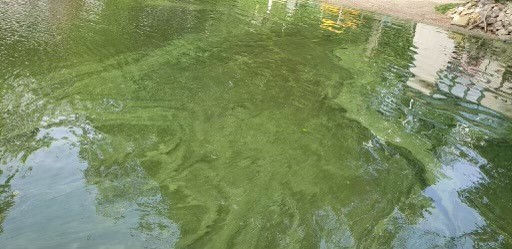Cyanobacteria
Contact
Multiple Cyanobacteria Blooms Observed Across Several New Hampshire Lakes
 Several cyanobacteria blooms were reported to NHDES on Wednesday, June 2. It is very common to see cyanobacteria blooms, or green surface scums, this time of year. Heavy rain can sometimes introduce nutrients that can spark the growth of cyanobacteria. These cells grow in the water column of lakes and rise to the surface, getting caught in the surface tension. Ultimately these blooms are carried and dispersed around the lake, driven by wind, currents and weather.
Several cyanobacteria blooms were reported to NHDES on Wednesday, June 2. It is very common to see cyanobacteria blooms, or green surface scums, this time of year. Heavy rain can sometimes introduce nutrients that can spark the growth of cyanobacteria. These cells grow in the water column of lakes and rise to the surface, getting caught in the surface tension. Ultimately these blooms are carried and dispersed around the lake, driven by wind, currents and weather.
NHDES is following up on several reports. There is currently an advisory for Robinson Pond in Hudson. Other waterbodies we are inspecting include: Swains Lake in Barrington, Island Pond in Stoddard, Highland Lake in Stoddard, Berry Bay-Lake Ossipee in Freedom, Webster Lake in Franklin, Tucker Pond in Salisbury and Province Lake in Effingham.
Surface blooms can rapidly change and accumulate in various locations around a waterbody. Please continue to monitor your individual shorelines for changing conditions. NHDES advises lake users to avoid contact with the water in areas experiencing elevated cyanobacteria cell conditions, also known as a bloom. NHDES also advises pet owners to keep their pets out of any waters that have a cyanobacteria bloom.
Cyanobacteria are natural components of water bodies worldwide, though blooms and surface scums may form when excess nutrients are available to the water. Some cyanobacteria produce toxins that are stored within the cells and released upon cell death. Toxins can cause both acute and chronic health effects that range in severity. Acute health effects include irritation of skin and mucous membranes, tingling, numbness, nausea, vomiting, seizures and diarrhea. Chronic effects may include liver and central nervous system damage. Be cautious of lake water that has a surface scum, changes colors, or appears to have green streaks or blue-green flecks aggregating along the shore.
Cyanobacteria alerts have been locally shared until samples can be collected by NHDES and staff can confirm cyanobacteria identification, enumeration and severity. Follow-up advisories will be posted.
Visit the NHDES Beach Program website for photos and more information about cyanobacteria.
View updates on cyanobacteria advisories.
Follow the Beaches twitter feed.
If you notice anything resembling cyanobacteria, please refrain from wading, swimming, or drinking the water. Keep all pets out of the water and contact NHDES immediately. Please call NHDES to report a cyanobacteria bloom at (603) 848-8094 or email HAB@des.nh.gov.




